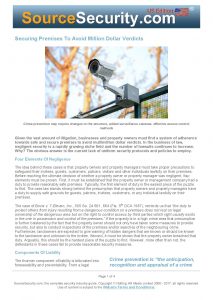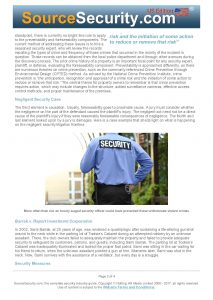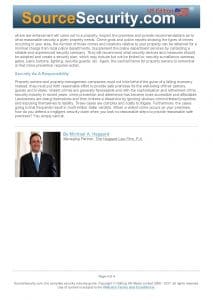When the market-leading information resource serving the security industry needs insight on how property owners and managers can avoid million dollar negligent security verdicts, it asks The Haggard Law Firm.
Haggard Law Firm Managing Partner Michael Haggard wrote an article for SourceSecurity.com titled: Securing Premises To Avoid Million Dollar Verdicts. In it, Haggard kays out the elements of negligence elaborate on risk-management practices and the importance of security as a responsibility.
Haggard Law has litigated more than 250 negligent security cases that have resulted in more than $300 million in verdicts and settlements for our clients.
Here is the article as it appeared on SourceSecurity.com:
Given the vast amount of litigation, businesses and property owners must find a system of adherence
towards safe and secure premises to avoid multimillion-dollar verdicts. In the business of law,
negligent security is a rapidly growing niche field and the number of lawsuits continues to increase.
Why? The obvious answer is the current lack of uniform security protocols and policies to employ.
Four Elements Of Negligence
The idea behind these cases is that property owners and property managers must take proper precautions to safeguard their invitees, guests, customers, patrons, visitors and other individuals lawfully on their premises. Before reaching the ultimate decision of whether a property owner or property manager was negligent, four elements must be proven. First, it must be established that the property owner or management company had a duty to provide reasonably safe premises. Typically, the first element of duty is the easiest piece of the puzzle to find. The case law stands strong behind the presumption that property owners and property managers have a duty to supply safe grounds for guests, patrons, invitees, customers, or any individual lawfully on their
premises. The case of Bovis v. 7-Eleven, Inc., 505 So. 2d 661, 664 (Fla. 5th DCA 1987), reminds us that “the duty to
The case of Bovis v. 7-Eleven, Inc., 505 So. 2d 661, 664 (Fla. 5th DCA 1987), reminds us that “the duty to protect others from injury resulting from a dangerous condition on premises does not rest on legal ownership of the dangerous area but on the right to control access by third parties which right usually exists in the one in possession and control of the premises.” If the property is in a high crime area that presumption is further bolstered by the fact that the property owner should not only have taken some measures to provide security, but also to conduct inspections of the premises and/or searches of the neighboring crime.
Furthermore, landowners are expected to give warning of hidden dangers that are known or should be known to the landowner and unknown to the invitee. Second, it must be shown that the property owner breached that duty. Arguably, this should be the hardest piece of the puzzle to find. However, more often than not, the defendants in these cases fail to provide reasonable security measures.
Components Of Liability
The thornier component of liability is bifurcated into foreseeability and preventability. From a legal recognition and appraisal of a crime risk and the initiation of some action
to reduce or remove that risk” standpoint, there is currently no bright line rule to apply to the preventability and foreseeability components. The current method of addressing these issues is to hire a seasoned security expert, who will review the records reporting the types of crime and frequency of those crimes that occurred in the vicinity of the incident in
question. Those records can be obtained from the local police department and through other avenues during the discovery process. The prior crime history of a property is an important focal point for any security expert, plaintiff, or defense, evaluating the foreseeability component. Preventability is approached differently, as there are numerous theories on crime prevention, such as the commonly referenced Crime Prevention through Environmental Design (CPTED) method. As echoed by the National Crime Prevention Institute, crime prevention is “the anticipation, recognition and appraisal of a crime risk and the initiation of some action to reduce or remove that risk.” The central theme for property owners to remember is that crime prevention requires action, which may include changes to the structure, added surveillance cameras, effective access control methods, and proper maintenance of the premises.
Negligent Security Case
The third element is causation. Usually, foreseeability goes to the proximate cause. A jury must consider whether the negligence on the part of the defendant caused the plaintiff’s injury. The negligent act need not be a direct cause of the plaintiff’s injury if they were reasonably foreseeable consequences of negligence. The fourth and last element looked upon by a jury is damages. Here is a case example that sheds light on what is happening on the negligent security litigation frontline. More often than not an hourly waged security officer could have prevented these unfortunate violent crimes.
Barrak V. Report Investment Corporation
In 2002, Sami Barrak, at 25 years of age, was rendered a quadriplegic after sustaining a life-altering gunshot
wound to the neck while in the parking lot of Tootsie’s Cabaret during an attempted robbery by an unknown
assailant. There, the club owners failed to adequately maintain the property and failed to provide adequate
security to safeguard its customers, patrons, and guests, including Sami Barrak. The parking lot at Tootsie’s
Cabaret was inadequately illuminated and lacked the proper foot patrol. Sami was sitting in the car waiting for
his friend to return when the unknown assailant pointed a gun at him. Moments later, Sami was shot in the
neck. Now, Sami survives with the assistance of a ventilator, but every day is a struggle.
Security Measures
SourceSecurity.com, the complete security industry guide. Copyright © Notting Hill Media Limited 2000 – 2017, all rights reserved. Use of content is subject to the Website Terms and Conditions.
It is important to note that different properties require different security needs; thus different standards should be implemented in different industries It was established that the defendant, Report Investment Corporation, had a duty to maintain the premises in a reasonably safe condition. Report Investment Corporation was found negligent after admitting that they never
spent one dollar on security or safety. During the seven years prior to Sami’s attack, there were approximately 26 violent crimes on the same property. Yet, nothing was done to cure the crime problem and ensure the safety of Tootsie’s patrons. The verdict awarded in favor of the Plaintiff was the largest jury verdict recorded for a negligent security case for $102.7 million, including $1.4 million for past medical expenses, $164,000 for past lost earnings, $28 million for future medical expenses, $650,000 for lost earning ability, $2.5 million for past pain and suffering and $70 million for future pain and suffering.
A disheartening fact of these cases is that more often than not an hourly waged security officer could have prevented these unfortunate violent crimes from occurring and saved a victim’s life. Frequently, it boils down to cost. As a result, property owners and property management companies are less inclined to spend the money and resources on adequate security measures. However, that is a costly mistake as evidenced above.
Haggard to Deliver Negligent Security Seminar DUring Security Industry Conference
Uniform Security Standards
The above case is just one example of the stark negligence of defendant property owners around the state of
Florida. These same issues exist on a national level, with, Texas, New York, and California as top negligent
security litigation contenders. That is precisely why nationally uniform industry standards need to be
implemented. It is important to note that different properties require different security needs; thus different
standards should be implemented in different industries. According to the Bureau of Justice Statistics, violent
victimisations and serious violent victimisations have declined in number in recent years. The numbers for
2010 reflect 3.8 million violent victimisations and 1.4 million serious violent victimisations, which is a 34%
decrease since 2001. If crime is on the decline, why is negligent security litigation such a growing sector?
Owners must find a system of adherence towards safe and secure premises to avoid multimillion dollar verdicts
Risk Management Practices
Owners must find a system of adherence towards safe and secure premises to avoid multimillion-dollar
verdicts. A security analysis must be done prior to purchasing any parcel or property. Secondly, a sound
security plan must be developed and enacted. Many local police departments offer free security analyses, where law enforcement will come out to a property, inspect the premises and provide recommendations as to what reasonable security a given property needs. Crime grids and police reports showing the types of crimes occurring in your area, the number of those crimes and locations relative to your property can be obtained for a minimal charge from local police departments. Supplement the police department services by contacting a reliable and experienced security company. They will recommend what security devices and measures should be adopted and create a security plan, which may include but not be limited to: security surveillance cameras, gates, panic buttons, lighting, security guards, etc. Again, the central theme for property owners to remember is that crime prevention requires action
.
Security As A Responsibility
Property owners and property management companies must not hide behind the guise of a failing economy. Instead, they must put forth reasonable effort to provide safe premises for the well-being of their patrons, guests, and invitees. Violent crimes are generally foreseeable and with the sophistication and refinement of the security industry in recent years, crime prevention and deterrence have become more accessible and affordable. Landowners are doing themselves and their invitees a disservice by ignoring obvious crime-infested propertiesand exposing themselves to liability. These cases are complex and costly to litigate. Furthermore, the cases going to trial frequently result in multi-million dollar verdicts. When a violent crime occurs on your premises, how do you defend a negligent security claim when you took no reasonable steps to provide reasonable safe premises? You simply cannot.
By Michael A. Haggard
Managing Partner, The Haggard Law Firm, P.A.



To view article as it appeared on SourceSecurity.com , click here












